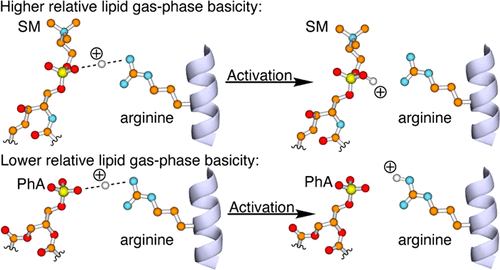当前位置:
X-MOL 学术
›
Anal. Chem.
›
论文详情
Our official English website, www.x-mol.net, welcomes your feedback! (Note: you will need to create a separate account there.)
Gas-Phase Protonation Thermodynamics of Biological Lipids: Experiment, Theory, and Implications.
Analytical Chemistry ( IF 7.4 ) Pub Date : 2020-07-06 , DOI: 10.1021/acs.analchem.0c00613 Zachary M Miller 1 , J Diana Zhang 2 , W Alexander Donald 2 , James S Prell 1, 3
Analytical Chemistry ( IF 7.4 ) Pub Date : 2020-07-06 , DOI: 10.1021/acs.analchem.0c00613 Zachary M Miller 1 , J Diana Zhang 2 , W Alexander Donald 2 , James S Prell 1, 3
Affiliation

|
Phospholipids are important to cellular function and are a vital structural component of plasma and organelle membranes. These membranes isolate the cell from its environment, allow regulation of the internal concentrations of ions and small molecules, and host diverse types of membrane proteins. It remains extremely challenging to identify specific membrane protein–lipid interactions and their relative strengths. Native mass spectrometry, an intrinsically gas-phase method, has recently been demonstrated as a promising tool for identifying endogenous protein–lipid interactions. However, to what extent the identified interactions reflect solution- versus gas-phase binding strengths is not known. Here, the “Extended” Kinetic Method and ab initio computations at three different levels of theory are used to experimentally and theoretically determine intrinsic gas-phase basicities (GB, ΔG for deprotonation of the protonated base) and proton affinities (PA, ΔH for deprotonation of the protonated base) of six lipids representing common phospholipid types. Gas-phase acidities (ΔG and ΔH for deprotonation) of neutral phospholipids are also evaluated computationally and ranked experimentally. Intriguingly, it is found that two of these phospholipids, sphingomyelin and phosphatidylcholine, have the highest GB of any small, monomeric biomolecules measured to date and are more basic than arginine. Phosphatidylethanolamine and phosphatidylserine are found to be similar in GB to basic amino acids lysine and histidine, and phosphatidic acid and phosphatidylglycerol are the least basic of the six lipid types studied, though still more basic than alanine. Kinetic Method experiments and theory show that the gas-phase acidities of these phospholipids are high but less extreme than their GB values, with phosphatidylserine and phosphatidylglycerol being the most acidic. These results indicate that sphingomyelin and phosphatidylcholine lipids can act as charge-reducing agents when dissociated from native membrane protein–lipid complexes in the gas phase and provide a straightforward model to explain the results of several recent native mass spectrometry studies of protein–lipid complexes.
中文翻译:

生物脂质的气相质子化热力学:实验、理论和影响。
磷脂对细胞功能很重要,是质膜和细胞器膜的重要结构成分。这些膜将细胞与其环境隔离,允许调节离子和小分子的内部浓度,并承载多种类型的膜蛋白。确定特定的膜蛋白-脂质相互作用及其相对强度仍然极具挑战性。天然质谱是一种本质上的气相方法,最近已被证明是鉴定内源性蛋白质 - 脂质相互作用的有前途的工具。然而,所识别的相互作用在多大程度上反映了溶液与气相结合强度尚不清楚。在这里,“扩展”动力学方法和从头算三个不同理论水平的计算用于实验和理论上确定六种脂质的固有气相碱度(GB,用于质子化碱基去质子化的ΔG)和质子亲和力(用于质子化碱基去质子化的PA,ΔH)常见的磷脂类型。气相酸度(Δ G和 Δ H中性磷脂的去质子化)也通过计算进行评估并通过实验进行排名。有趣的是,发现这些磷脂中的两种,鞘磷脂和磷脂酰胆碱,在迄今为止测量的任何小单体生物分子中具有最高的 GB,并且比精氨酸更碱性。发现磷脂酰乙醇胺和磷脂酰丝氨酸在 GB 中与碱性氨基酸赖氨酸和组氨酸相似,磷脂酸和磷脂酰甘油是所研究的六种脂质类型中碱性最低的,但仍比丙氨酸碱性更强。动力学方法实验和理论表明,这些磷脂的气相酸度较高,但没有其 GB 值那么极端,其中磷脂酰丝氨酸和磷脂酰甘油的酸性最强。
更新日期:2020-08-04
中文翻译:

生物脂质的气相质子化热力学:实验、理论和影响。
磷脂对细胞功能很重要,是质膜和细胞器膜的重要结构成分。这些膜将细胞与其环境隔离,允许调节离子和小分子的内部浓度,并承载多种类型的膜蛋白。确定特定的膜蛋白-脂质相互作用及其相对强度仍然极具挑战性。天然质谱是一种本质上的气相方法,最近已被证明是鉴定内源性蛋白质 - 脂质相互作用的有前途的工具。然而,所识别的相互作用在多大程度上反映了溶液与气相结合强度尚不清楚。在这里,“扩展”动力学方法和从头算三个不同理论水平的计算用于实验和理论上确定六种脂质的固有气相碱度(GB,用于质子化碱基去质子化的ΔG)和质子亲和力(用于质子化碱基去质子化的PA,ΔH)常见的磷脂类型。气相酸度(Δ G和 Δ H中性磷脂的去质子化)也通过计算进行评估并通过实验进行排名。有趣的是,发现这些磷脂中的两种,鞘磷脂和磷脂酰胆碱,在迄今为止测量的任何小单体生物分子中具有最高的 GB,并且比精氨酸更碱性。发现磷脂酰乙醇胺和磷脂酰丝氨酸在 GB 中与碱性氨基酸赖氨酸和组氨酸相似,磷脂酸和磷脂酰甘油是所研究的六种脂质类型中碱性最低的,但仍比丙氨酸碱性更强。动力学方法实验和理论表明,这些磷脂的气相酸度较高,但没有其 GB 值那么极端,其中磷脂酰丝氨酸和磷脂酰甘油的酸性最强。



























 京公网安备 11010802027423号
京公网安备 11010802027423号